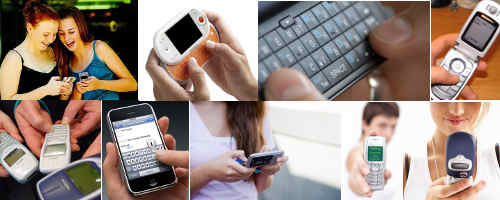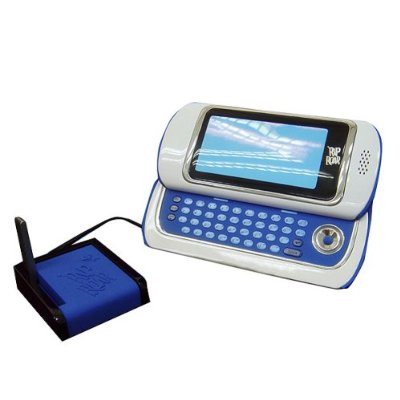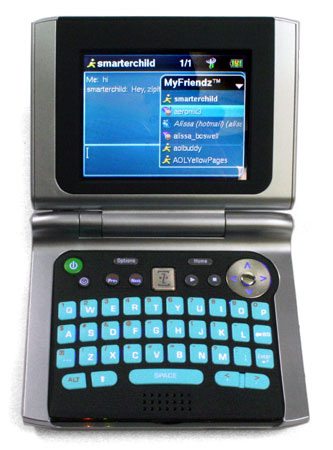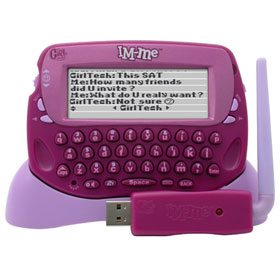
I’m an avid reader of the Consumerist. I also talk to Julie online a lot, which means that I’m frequently sending her links during the day to interesting articles I find. We got into a discussion about texting, after I sent her an article on a girl in Colorado who racked up a $4,756.25 Verizon bill from texting one month. She sent roughly 10,000 messages…and received just as many! That’s a lot of texting, even for a teenager. Last month, I also saw an article on the Consumerist about a California teenager who managed to send and receive over 14,000 text messages one month on an AT&T plan. Fortunately, her parents had an unlimited messaging plan on her phone.
But when you don’t want to pay for unlimited messaging, what can you do about a kid whose thumbs move faster than Road Runner’s mad dash away from Wile E. Coyote?
I’ve been both an AT&T and a Verizon customer, and I know just how much text messages can cost. With AT&T, unlimited texting is an extra $20 a month. It’s $30 a month if you have a family plan and want to add unlimited texting to every line on the plan. Verizon’s plan isn’t quite as good – $20 a month will get you 5,000 messages, plus unlimited messages to other Verizon mobile numbers. Back when I was on Verizon with my former employer’s corporate discount, I ponied up the extra $10 a month for 500 messages, plus unlimited mobile-to-mobile – which worked for me, since I only really texted people with Verizon numbers.
When I got my iPhone and switched to AT&T, I decided it wasn’t worth the money – especially since I got email directly to my phone. So I called up AT&T, had texting completely blocked from my number, and told everyone to text me at an email address I set up just for my iPhone. That was three months ago, and it’s been working out well.
Kids, however, aren’t so accommodating to Mom and Dad’s tight wallet. More and more I see tweens and teens at the mall with BlackBerries and iPhones and SideKicks, madly texting away.
Then again, teenagers don’t really need cell phones. By FCC regulations, any cell phone (even ones that aren’t activated) must be capable of calling 911, so that kills the “I need it for emergencies, Mom!” excuse. There’s also the whole concept of what life was like before cell phones…and, like the teenager in Colorado, your kid’s grades might be impacted by their constant calling and texting while at school.
I decided to do a little searching to see if there were any alternatives, especially for younger kids (like the 10-13 “tween” types). What options are out there for satiating a teenager’s desire to be forever connected to her BFF, even at 4 AM? High-count text message plans on top of a line on your family plan will cost, at minimum, $30 a month. Text-only plans usually end up costing more over the long run. So what can you do?
Surprisingly, I found a few different options.
Rip Roar im
 The Rip Roar im is a small device with a monochrome LCD and a slide-out QWERTY keyboard. It works over the 900MHz wireless band (like older cordless phones) and allows you to use your existing accounts with AOL, Yahoo!, and MSN. It connects wirelessly to a USB transmitter you connect to any Internet-connected computer. While it’s not a cellular device, it will get the kids off the computer, and they can contact their friends no matter where they are at home. Its MSRP is $79.99, but Target.com carries it for a mere $20 – not too shabby.
The Rip Roar im is a small device with a monochrome LCD and a slide-out QWERTY keyboard. It works over the 900MHz wireless band (like older cordless phones) and allows you to use your existing accounts with AOL, Yahoo!, and MSN. It connects wirelessly to a USB transmitter you connect to any Internet-connected computer. While it’s not a cellular device, it will get the kids off the computer, and they can contact their friends no matter where they are at home. Its MSRP is $79.99, but Target.com carries it for a mere $20 – not too shabby.
Zipit Wireless Messenger
 The Zipit Wireless Messenger is a wifi-enabled device, available at both Target and Best Buy (according to the manufacturer’s website). At $49.99 MSRP, it costs a bit more, but it comes with a slew of awesome, teen-friendly features. Equipped with a mini-SD slot and full-color LCD, the Zipit can play MP3s and display digital pictures. It can even play Internet radio stations over its 802.11g-compliant wireless connection. The device itself flips open and has a QWERTY keyboard. There’s one caveat – initial purchase requires activation of a one-year service plan at $9.99 a month, which provides texting access in addition to IM access on AOL, Yahoo!, and MSN. After the year is up, you can use the Zipit for IM at no monthly fee.
The Zipit Wireless Messenger is a wifi-enabled device, available at both Target and Best Buy (according to the manufacturer’s website). At $49.99 MSRP, it costs a bit more, but it comes with a slew of awesome, teen-friendly features. Equipped with a mini-SD slot and full-color LCD, the Zipit can play MP3s and display digital pictures. It can even play Internet radio stations over its 802.11g-compliant wireless connection. The device itself flips open and has a QWERTY keyboard. There’s one caveat – initial purchase requires activation of a one-year service plan at $9.99 a month, which provides texting access in addition to IM access on AOL, Yahoo!, and MSN. After the year is up, you can use the Zipit for IM at no monthly fee.
Unlike the Rip Roar im, the Zipit works on any wireless network or hotspot, so your teen can take it with them and use it anywhere with an open hotspot. As more and more locations provide free wireless, this device can be pretty useful while minimizing your monthly expenses. It also allows parents to limit how much it can be used, and parents can keep track of who their kids are talking to. When you’re dealing with a thirteen-year-old, this can really bring some peace-of-mind to parents.
And, for the geeks out there, it even runs Linux! Who knew?
GirlGear IM-Me
 For the younger set, you might consider the GirlGear IM-Me. It’s a girly pink-and-purple device with an MSRP of $44.99 – but it’s available on Amazon.com for only $13.49. This toy is definitely geared at younger kids between the ages of about eight and twelve. It, like the Rip Roar im, works over the 900MHz band, but it provides several parental controls that allow you to know who your kid is talking to at any time. The IM-Me uses its own instant messaging protocol, so it won’t work with AOL, Yahoo!, MSN, or any other existing IM service. A trial application is available to allow you to chat via a computer with someone using an IM-Me – although the manufacturer’s site isn’t particularly clear about what it means by “free trial”, I’m guessing that it’s a time-limited deal in order to convince you to buy more IM-Me devices. The IM-Me device comes with a USB transmitter, a docking cradle, and has a QWERTY keyboard and backlit monochrome LCD. This is definitely not a device for teenagers, but it’s a great way to let your younger daughter have a way to communicate with her friends that doesn’t cost you any extra money on your already bulky cell phone plan.
For the younger set, you might consider the GirlGear IM-Me. It’s a girly pink-and-purple device with an MSRP of $44.99 – but it’s available on Amazon.com for only $13.49. This toy is definitely geared at younger kids between the ages of about eight and twelve. It, like the Rip Roar im, works over the 900MHz band, but it provides several parental controls that allow you to know who your kid is talking to at any time. The IM-Me uses its own instant messaging protocol, so it won’t work with AOL, Yahoo!, MSN, or any other existing IM service. A trial application is available to allow you to chat via a computer with someone using an IM-Me – although the manufacturer’s site isn’t particularly clear about what it means by “free trial”, I’m guessing that it’s a time-limited deal in order to convince you to buy more IM-Me devices. The IM-Me device comes with a USB transmitter, a docking cradle, and has a QWERTY keyboard and backlit monochrome LCD. This is definitely not a device for teenagers, but it’s a great way to let your younger daughter have a way to communicate with her friends that doesn’t cost you any extra money on your already bulky cell phone plan.
Of course, at the end of the day, one has to wonder just how critical it is for kids these days to be always-connected. I’m no stranger to the addicting qualities of being perpetually tethered to cyberspace, believe me. On the flip side, I was raised in a financially conservative family, where we didn’t have cable TV, let alone cell phones. I got my first phone when I was a senior in high school – and it was prepaid because I couldn’t sign a contract yet!
If you’re having trouble getting your teenaged kids to tone down their cell usage, it might be time to start pushing them to get a job and pay for their own service – or, at least, the texting add-on to their line of the family’s cell plan. If you just want your child to have a phone for emergencies, consider T-Mobile’s prepaid plans. I ended up getting a T-Mobile phone for my mother. The phone was $69.99, and for $100, I got her a year of minutes. She only has to pay as little as $20 a year to keep her existing minutes renewed. Since she hardly ever uses her phone, it works out perfectly – and it’s a very cost-effective way to provide a phone to your kids if it’s that important to you that they have one.
None of the devices I found work on a cellular network – for that functionality, you’re stuck continuing to pay for a normal cell phone with a messaging add-on. However, if your kid just wants a way to message their friends while at home, the products I found might just be the ticket.



Gadgeteer Comment Policy - Please read before commenting
Wow, awesome post! I use anywhere from 12,000 – 16,000 messages a month. That includes regular SMS, AIM forwarding and twitter alerts. I use AT&T with the iPhone 3G.
Informative. But your three devices need access to wifi, or a computer. Your teenager is not going to stay within three hundred feet of a wifi to text. With the cell phone he can go anywhere. but at least these are a start.
Great idea!
I actually just sent a letter to my Atty General asking him to investigate the collusion that is occurring in the wireless industry. It seems that every time one provider raises it’s texting rates, the others follow within a few months. There is no real competition.
An appalling thing is if you want to use the IM client that comes on your phone (unless you have a PDA phone), they use BOTH your data and text plans. We all know IMs pass over the data network, but I know at least that AT&T ALSO charges each message sent and received as a text.
It is especially appalling because text messages are sent over “extra” bandwidth on the network, effectively costing the provider nothing to send and receive them. They also have peering relationships, where AT&T doesn’t have to pay anything to send a text to a Verizon number, as long as the inverse is true.
Who knows if anything will ever come of it, but I do know that NC’s Atty general is very much out for the consumer…he sent out thousands of cease and desists and fines this past summer when the “gas crisis” hit and stations were gouging customers.
These all look like great devices for the home, but as others have said, what do they do when they are not within range?
My suggestion is to get them a pay as you go or pre-paid phone, as Claire mentions, for the times away from home. This will teach them “restraint”….which should be learned anyways.
These devices definitely aren’t for high school age kids who are out and about a lot, but they might work well for junior highers who are at home more often.
Another device worth a look at is the Peek. It works off cellular coverage and has fixed monthly cost. Though it is based on E-mail you can always txt to a email address and email a txt’er at their respected address…
You might want to try the PEEK which now supports unlimited txt msg. It’s an email only device so no IMs. And it’s a flat rate $19.95 a month for unlimited emails and txt msg. It uses cellular frequency provided by tmobile so it doesn’t have to rely on being near wifi. I gave one to my cousin and he loves it. Pretty much like a blackberry but without the phone function. getpeek.com
As a high school chemistry teacher, cell phones are the bane of the classroom. Girls keep their hands in their purses to hide their texting activities, boys keep their hands under the desk. It gets to the point where I want to smash the damned things. These kids are so addicted that they get violent if you confiscate them. Schools should have the right to block cell signals. Cell phones have no place there.
About communications devices used at/in school. Yes, I agree that it’s not a good thing to allow students to do this instead of participating in class activities.
However…
When I was in school, calculators, erasable ink pens, and spiral-bound note pads (to list a few items), were not allowed. Things change and it’s part of the teaching community’s responsibility to see these changes and incorporate them into their curriculum. You have two choices. Remove the devices as my teachers (and parents) did, or allow them and integrate them into the class structure… but chose one of these and stop filling the Internet with the complaining.
Phil
@Mark: I wholeheartedly agree. I attended a small private school K-12, so the rules were a bit different. Students were not allowed to have any electronic devices out during the school day, including cell phones, computers, CD players (ah yes…the days before the iPod…), or even GameBoys. Amazingly, students survived. We were allowed to use the main office phone for local calls if there was some kind of emergency, but that was it. I’m surprised schools don’t take a stricter stance on banning phones and other such devices from the classroom.
They make cell phone jammers, Mark. Just don’t let them catch you using it. 😉
@blacknimbus
Cell phone jammers should be mandatory in classrooms. 🙂
I think this whole “gotta have a cell phone in school” thing came about after the Columbine massacre. Its too bad that it has come to this because there really is very litttle need for cell phones in class rooms.
if paying the extra few dollars for a plan or add-on with unlimited texting is too much for you… let’s be honest.. you shouldn’t be paying for a cell phone for your kid. Parents like this baffle me.
@Marc: While I agree that most kids don’t need a free cell phone, consider how much the add-ons can end up costing. At $20 per line (and you’re already paying at least $10 per line to have a family plan), if you have more than one kid, it’s going to add up fast.
I think that prepaid is the way to go with kids. It forces responsibility on them – they can’t go over, because once they run out of minutes, the phone just quits working.
I couldn’t agree more, the best choice is definitely prepaid. But if you’ve got a family plan anyway, unlimited texting can be as low as $5/mo, if not already included.